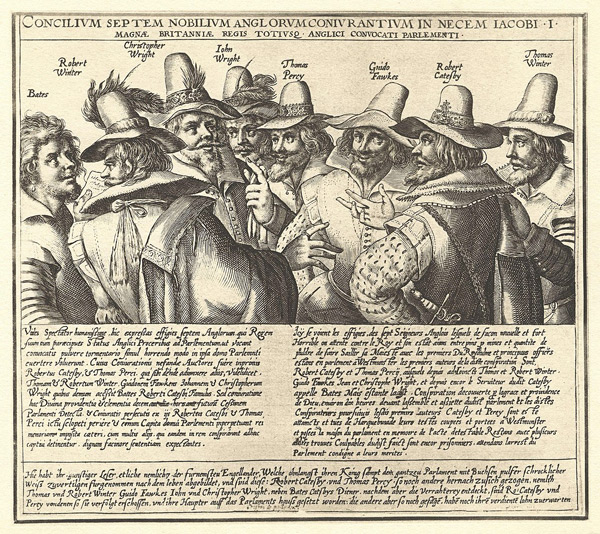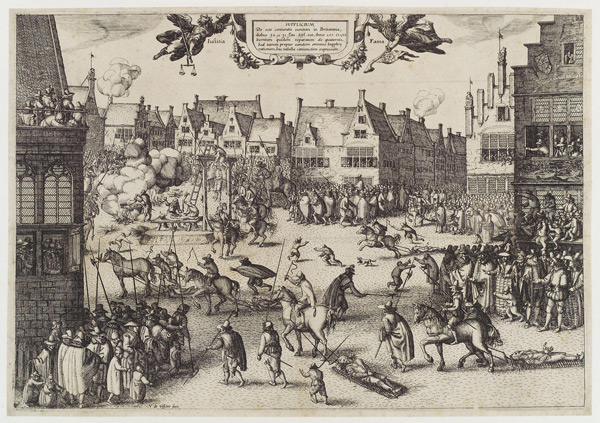Most Americans know nothing of Guy Fawkes or why he’s celebrated every November 5th. However, if the patriots hadn’t won the American Revolution, chances are that we’d be standing around bonfires in the evening of every November 5. Our colonial ancestors actually did these things. Today, Bonfires and fireworks are the order of the evening in the U.K., and folks have great fun. What’s this all about? Alan Moore had famous line,”Remember the 5th of November…” And so they have, since 1605 – 416 years ago.
November 5 marks the anniversary of the discovery of the plot to blow up the English Houses of Parliament and kill King James I. It seems that King James I wasn’t tolerant of Catholics at all. In hopes of changing the government to one that would see things the Catholic way, what is known as the Gunpowder Plot was conceived and was nearly successful. Guy Fawkes was a member of the group (led by Robert Catesby) who put the plan together. His father had been persecuted by Queen Elizabeth. Thirty-six barrels of gunpowder were secreted into a cellar beneath the House of Lords. Parliament was soon to open, was postponed several times due to the Plague, but was now scheduled for the 5th of November, 1605.
However, to keep a secret of something this horrendous in nature is nigh on to impossible. Someone sent any anonymous letter to the brother-in-law of one of the conspirators, telling him not to attend parliament on that day. The building was searched and Guy Fawkes found in the cellar, and arrested. Under torture, Fawkes revealed the names of his co-conspirators.
 The above is a contemporary engraving of eight of the thirteen conspirators, by Crispijn van de Passe. Missing are Digby, Keyes, Rookwood, Grant, and Tresham. Public Domain, from Wikipedia Commons.
The above is a contemporary engraving of eight of the thirteen conspirators, by Crispijn van de Passe. Missing are Digby, Keyes, Rookwood, Grant, and Tresham. Public Domain, from Wikipedia Commons.
Folks lit bonfires around London when they heard that the King had survived the assassination attempt. The following January, Parliament passed the Thanksgiving Act and made November 5 an annual holiday. The day was known as the Gunpowder Treason Day, and became a day of commemorating long-held grievances against the Catholic faith. Figures of people that were hated were often burned in effigy – the pope being one of them. During the 18th Century, children began begging with effigies of Guy Fawkes, and the day slowly became Guy Fawkes Day.
The celebration today is much less anti-Catholic, but the bonfires persist. By the 20th Century, Guy Fawkes Day was a day of social commemoration. As I mentioned above, the celebration did make its way to America, but died out with the American Revolution.
What happened to Guy Fawkes? He and his coconspirators who remained alive were tried on January 27, 1606 in Westminster Hall for high treason. All were convicted, with their executions taking place on the 30th and 31st of January. They were hung, drawn and quartered. Fawkes execution was to take place on the 31st. However, while climbing the ladder to the hanging platform, he jumped, broke his neck and immediately died.
The participants in the plot were Robert Catesby, John and Christopher Wright, Robert and Thomas Wintour, Thomas Percy, Guy Fawkes, Robert Keyes, Thomas Bates, John Grant, Ambrose Rookwood, Sir Everand Digby and Francis Tresham.
A group of the men had made a run for it, and did not get far. Robert Catesby was shot and killed at Holbeche House while making a stand against the Sheriff of Worcester on November 8. John Wright was then shot, followed by his brother Christopher. Then Rookwood was shot. Catesby and Percy were killed by one lucky shot. The dead and dying were stripped of their clothing. Grant, Morgan, Rookwood and Wintour were arrested. Bates, Keyes and Digby were soon captured. Tresham was arrested on the 12th, and taken to the Tower of London. Montague, Mordaunt, and Stourton (Tresham’s brother-in-law) were also arrested, and taken to the tower.
On January 30, 1606 Thomas Bates, Sir Everand Digby, John Grant and Robert Winter were executed in St. Paul’s church yard. The following day, the other four men, Robert Keyes, Ambrose Rookwood, Thomas Winter, and Guy Fawkes met their fate – Fawkes doing it his own way and breaking his neck. They were executed outside Westminster Hall, in the Old Palace Yard.

There have been scores of books written about the gunpowder plot. Many are very old and long out of print, but you can access them at the Internet Archive. See: https://archive.org/details/texts?query=The+Gunpowder+Plot
Click on the above illustrations to see the high definition images.